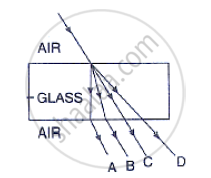Advertisements
Advertisements
प्रश्न
An object is placed at a distance of 15 cm from a concave lens of focal length 30 cm. List four characteristics (nature, position, etc.) of the image formed by the lens.
उत्तर
Here, object distance, u = -15 cm
and focal length, f = -30 cm
Using lens formula,
`1/f = 1/v − 1/u`
`1/(−30) = 1/v − 1/(−15)`
`1/v = −1/30 − 1/15`
`v = − 10 cm`
Magnification, `m=v/u=(−10)/(−15)=+23`
Four characteristics of the image formed by the concave lens are :
(i) Image formed is virtual
(ii) Image is erect
(iii) Image is formed on the same side of the lens as the object
(iv) Image is smaller than the object
APPEARS IN
संबंधित प्रश्न
To determine the approximate focal length of the given convex lens by focussing a distant object (say, a sign board), you try to focus the image of the object on a screen. The image you obtain on the screen is always
(a) erect and laterally inverted
(b) erect and diminished
(c) inverted and diminished
(d) virtual, inverted and diminished
Where should an object be placed so that a real and inverted image of the same size as the object is obtained using a convex lens?
Describe with the help of a ray-diagram, the formation of image of a finite object placed in front of convex lens between f and 2f. Give two characteristics of the image so formed.
Describe with the help of a ray diagram the nature, size and position of the image formed when an object is placed at infinity (considerable distance) in front of a convex lens. State three characteristics of the image so formed.
A camera fitted with a lens of focal length 50 mm is being used to photograph a flower that is 5 cm in diameter. The flower is placed 20 cm in front of the camera lens.
At what distance from the film should the lens be adjusted to obtain a sharp image of the flower?
In figure , name the ray which represents the correct path of light while emerging out through
a glass block.

A converging lens forms the image of an object placed in front of it, beyond 2F2 of the lens. Draw a ray diagram to show the formation of the image.
A student places a 8.0 cm tall object perpendicular to the principal axis of a convex lens of focal length 20 cm. The distance of the object from the lens is 30 cm. He obtains a sharp image of the object on a screen placed on the other side of the lens. What will be the nature (inverted, erect, magnified, diminished) of the image he obtains on a screen? Draw ray diagram to justify your answer.
State the position of object, position of image, nature of image when: Convex lens is used in observing biological specimens.
